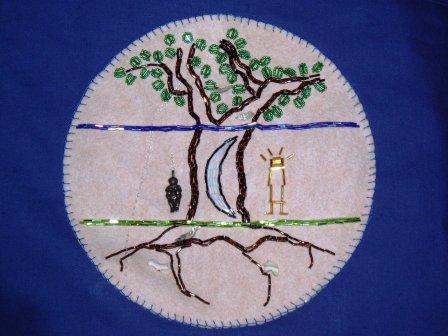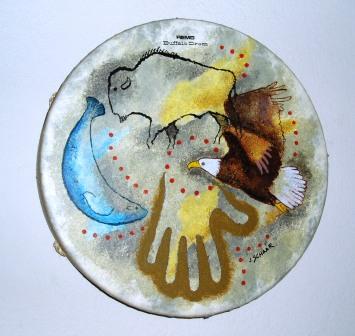Shamanism FAQ
Facts ~ Definitions ~ Tidbits
What’s It’s?
And How’s That’s?
Of Shamanism 101
Shamanism FAQ helps you to learn the language and mind-set of Shamanism and Shamanic Healing as it is practiced in America today. I start out with basic definitions to give you background about what you will be reading about in this site an on the Web in general.
The information in FAQs reflects my own understanding and experience gained over many years of formal study in shamanism and by direct teaching from my Spirit Allies.
This section is ever evolving and by no means answers everything. Please feel free to contact me with your questions.
FAQs ~ Definitions
Shaman – A person who journeys to worlds of Non-ordinary Reality to bring back information and healing for a client or for themselves. The word comes from the Siberian Tungus people and was popularized by modern anthropologists.
Shamunka – A female Shaman in the Tungus language.
Shamanism – A methodology for gaining information and/or healing the self and others consisting of a core of techniques used by tribal people around the world.
Journey – A method for moving ones’ consciousness into the world of spirit, traveling within that world, and bringing back into ordinary reality information or healing for self or another.
Spirit – Energetic beings who may have resided on earth at one time, who can be contacted in altered states of consciousness.
Spirit Teacher – A spirit being who has experienced an earth life and who has chosen to act as a teacher or guide for a human being.
Human Being – A spirit choosing to have a physical life or incarnation on earth.
Power Animal – A spirit of an animal who has chosen to act as a guide or helper to a human being, or another animal, currently in an incarnation on earth.

Beadwork Drum Bag Of The Three Worlds
I Made As A Project
For An Anthropology Class
Taught By Hank Wesselman, PhD
The Three Worlds – Shamans divide non-ordinary reality into three worlds.
The Lower World: An area below the Middle World inhabited mainly by animal spirits.
The Middle World: The area of our collective earth experience. Right here where we all agree we are now.
The Upper World: An area above the Middle World inhabited mainly by humanoid spirits who have passed on.
Non-ordinary reality – The worlds across the veil or areas of consciousness other than ordinary waking consciousness.
Ordinary Reality – Normal waking consciousness.
Healing of spirit – Bringing the spirit into balance, bringing back lost soul parts, removing “other” influences.
Shamanic Pet Healer - A person who uses the same Shamanic Healing modalities for animals as for people. See Pet Healing Psychopomp – Noun: A guide for the dead. Psychopomp Verb: to guide the dead to a place where they will receive help and healing.
Seeing – A way of gathering information in non-ordinary reality. Often includes actual visual experience, audible experience, feeling, and knowing. What you experience behind your eyelids.

Choose A Starting Place In Nature
Starting place – A place to begin and end a journey in order to have control over leaving and returning to ordinary reality. Chose a place you actually know in nature like a tree or an animal burrow.
It is very important to choose and use a starting place always. Stay with the same starting place until one of your spirits tells you to change. Leaving and returning through the starting place insures that you know you have returned and are back in your body when you open your eyes.
Journey into non-ordinary reality, do your work, and journey back to ordinary reality. In this way you will be able to walk in both worlds safely and joyfully.
Mission or intention – The reason for your journey. A shaman does not journey for kicks, for fun, or just to see what will happen.
Transition zone – An energetic barrier one must pass through in order to enter the Upper World. Also, an energetic barrier one must pass through when journeying through time in the Middle World.
Call back – A change in the beat of the drum that signals your time to return from your journey. The call back beat is at the end of the journey to remind you to end the journey and return to your body. You can use a drumming tape, a partner to drum for you, or drum for yourself while journeying in a sitting position. If you should return from a journey and find yourself feeling irritable, grouchy and out-of-sorts, or one or both of your eyes will not focus properly, play the call back beat again or have someone play it for you. After a second call back, you should find that you are completely back now and everything is normal.
Tunnel – A tube or tunnel-like structure that you travel down to go to the Lower World.

My Personal Drum
Painted By Artist
Jim Schaar
Drumming – The sound of the drum is the “horse” the shaman rides to journey to other worlds. The beat is usually, but not always, monotonous and steady ending in a call back beat.
Journal – Journal your journeys. Keep a diary or journal of the questions you asked and the answers and experiences you received. This helps you to remember significant information and acts as a reference for you. Your Journal is important. Your work in Non-Ordinary Reality can be as ephemeral as dreaming and writing it down not only makes it a more solid experience, but helps you remember the details.
Merge – To become one with another spirit. To blend your spirit with theirs and know each other’s experience. Always unmerge when you are done.
Blurred vision or irritability – Immediately after a journey may mean you have not completely returned from the journey. Play a callback beat again on your CD or your drum or have someone do it for you on the drum.
Shapeshifting – Changing form or appearance.
Core Shamanism – The methods and practices of shamanism worldwide without the cultural overlay. There are practices that are common to shamans everywhere, however, the way these practices appear or are performed differ from culture to culture. Soul Retrieval, Divination, Psychopomp Work, Extraction Healing, and Power Restoration or Retrieval are examples of “universal” practices.
Core Shamanism is a term coined by Michael Harner, PhD, founder of the Foundation For Shamanic Studies.
Shamanism FAQs will be constantly changing and updated over time. Thank you for visiting my FAQ page. I invite you to return and please do contact me with your questions.